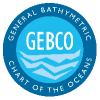Since 2014 GEBCO has made its gridded data sets available as a Web Map Service (WMS).
Find out how to access WMS layers for the latest release.
WMS layers for previous grid releases are available from the links below:
- WMS for the GEBCO_2021 Grid
- WMS for the GEBCO_2020 Grid
- WMS for the GEBCO_2019 Grid
- WMS for the GEBCO_2014 Grid
Further details
GEBCO_2021 WMS
The GEBCO_2021 Grid was published in July 2021 and is available as a Web Map Service (WMS).
Layers are available, for the global elevation map as a shaded relief image or 'flat' map and the GEBCO Type Identifier (TID) grid. These layers can be viewed in a web browser or Geographic Information System (GIS) and incorporated in your own web application.
Accessing the WMS for the GEBCO_2021 Grid
To access the GEBCO_2021 WMS, enter the following address into your WMS client
https://wms.gebco.net/2021/mapserv?
Supported service requests
GetCapabilities
This request returns information about the layers contained in the service, for example, their content and geographic extent. The information is returned in the form of a XML file (you may need to save this to disk to view the information).
The following links provide access to example GetCapabilities calls to GEBCO's WMS.
- WMS 1.3.0 GetCapabilities request for the global GEBCO_2021 grid
GetMap
This request returns a map. Using the information given in the GetCapabilities request, the user can specify parameters such as the required layer, the geographic extent of the map and the size of the returned image.
GEBCO_2021 Grid - with ice surface elevation information
- WMS 1.3.0 GetMap request for the global GEBCO Grid displayed as a shaded relief image
- WMS 1.3.0 GetMap request for the global GEBCO Grid displayed as a 'flat map' image, colour-coded for elevation
- WMS 1.3.0 GetMap request for the global GEBCO Grid displayed as a 'flat map' image, colour-coded for elevation, showing areas based on measured data only
GEBCO_2021 Grid - with sub-ice topography/bathymetry information
- WMS 1.3.0 GetMap request for the global GEBCO Grid displayed as a shaded relief image
- WMS 1.3.0 GetMap request for the global GEBCO Grid displayed as a 'flat map' image, colour-coded for elevation
GEBCO_2021 Type Identifier (TID) Grid
- WMS 1.3.0 GetMap request for the global TID Grid - grid cells based on measured data are shown in black
- WMS 1.3.0 GetMap request for the global TID Grid - grid cells colour-coded by TID value
GEBCO_2020 WMS
The GEBCO_2020 Grid was published in May 2020 and is available as a Web Map Service (WMS).
Layers are available, for the global elevation map as a shaded relief image or 'flat' map and the GEBCO Type Identifier (TID) grid. These layers can be viewed in a web browser or Geographic Information System (GIS) and incorporated in your own web application.
Accessing the WMS for the GEBCO_2020 Grid
To access the GEBCO_2020 WMS, enter the following address into your WMS client
https://wms.gebco.net/2020/mapserv?
Supported service requests
GetCapabilities
This request returns information about the layers contained in the service, for example, their content and geographic extent. The information is returned in the form of a XML file (you may need to save this to disk to view the information).
The following links provide access to example GetCapabilities calls to GEBCO's WMS.
- WMS 1.3.0 GetCapabilities request for the global GEBCO_2020 grid
GetMap
This request returns a map. Using the information given in the GetCapabilities request, the user can specify parameters such as the required layer, the geographic extent of the map and the size of the returned image.
- WMS 1.3.0 GetMap request for the global GEBCO_2021 Grid displayed as a shaded relief image
- WMS 1.3.0 GetMap request for the global GEBCO_20210 Grid displayed as a 'flat map' image, colour-coded for elevation
- WMS 1.3.0 GetMap request for the global GEBCO_2020 TID Grid - grid cells based on measured data shown in black
GEBCO_2019 WMS
The GEBCO_2019 Grid was published in May 2019 and is available as a Web Map Service (WMS).
Layers are available, for the global elevation map as a shaded relief image or 'flat' map and the GEBCO Type Identifier (TID) grid. These layers can be viewed in a web browser or Geographic Information System (GIS) and incorporated in your own web application.
Accessing the WMS for the GEBCO_2019 Grid
To access the GEBCO_2019 WMS, enter the following address into your WMS client
https://wms.gebco.net/2019/mapserv?
Supported service requests
GetCapabilities
This request returns information about the layers contained in the service, for example, their content and geographic extent. The information is returned in the form of a XML file (you may need to save this to disk to view the information).
The following links provide access to example GetCapabilities calls to GEBCO's WMS.
- WMS 1.3.0 GetCapabilities request for the global GEBCO_2019 grid
GetMap
This request returns a map. Using the information given in the GetCapabilities request, the user can specify parameters such as the required layer, the geographic extent of the map and the size of the returned image.
- WMS 1.3.0 GetMap request for the global GEBCO_2019 Grid displayed as a shaded relief image
- WMS 1.3.0 GetMap request for the global GEBCO_2019 Grid displayed as a 'flat map' image, colour-coded for elevation
- WMS 1.3.0 GetMap request for the global GEBCO_2019 TID Grid - grid cells based on measured data shown in black
WMS layers for the GEBCO_2014 Grid
The GEBCO_2014 Grid was published in 2014. To access the WMS layers for the data set, enter the following address into your WMS client
For the global map: https://wms.gebco.net/2014/mapserv?
For a view centred on the North Pole: https://wms.gebco.net/north-polar/mapserv?
For a view centred on the South Pole: https://wms.gebco.net/south-polar/mapserv?
Further details are given below about supported service requests and how to view a WMS are given below.
Supported service requests
The following service requests are supported by this WMS
GetCapabilities
This request returns information about the layers contained in the service, for example, their content and geographic extent.
The following links provide access to example GetCapabilities calls
- WMS 1.3.0 GetCapabilities request for the global GEBCO_2014 grid
- WMS 1.3.0 GetCapabilities request for the GEBCO_2014 grid centred on the North Pole (north of 50°N)
- WMS 1.3.0 GetCapabilities request for the GEBCO_2014 grid centred on the South Pole (south of 50°S)
GetMap
This request returns a map. Using the information given in the GetCapabilities request, the user can specify parameters such as the required layer, the geographic extent of the map and the size of the returned image.
- WMS 1.3.0 GetMap request for the global GEBCO_2014 Grid
- WMS 1.3.0 GetMap request for the global GEBCO_2014 Source Identifier Grid
- WMS 1.3.0 GetMap request for the GEBCO_2014 Grid centred on the North Pole (north of 50°N)
- WMS 1.3.0 GetMap request for the GEBCO_2014 Grid centred on the South Pole (south of 50°S)
GetFeatureInfo
Retrieves the underlying data values for a pixel location on a map. For the GEBCO Source Identifier (SID) Grid, a link is provided to metadata about the source data set that the GEBCO grid is based on at this location.
The following are example GetFeatureInfo requests for GEBCO's WMS.
- WMS 1.3.0 GetFeatureInfo request for elevation value from the global GEBCO_2014 Grid
- WMS 1.3.0 GetFeatureInfo request for Source Identification information from the global GEBCO_2014 SID Grid
How can I view a WMS?
WMS are designed to allow imagery to be shared over the internet, i.e. within your own application or software package you can access a map hosted on a remote server.
The GetMap request can be used to view a WMS in a web browser. Just cut and paste this URL into your browser to view the WMS image; changing the BBOX values alters the geographic extent of the area viewed.
The GetCapabilities request provides information about the image layers contained in the WMS.
There are a number of commercial and free GIS and mapping-type packages in which you can view WMS.
Please note that the quality of the viewed image may depend on how the software package interprets the WMS.
Disclaimer
This WMS has been developed and made available, on behalf of GEBCO, by the British Oceanographic Data Centre (BODC).
Whilst every effort has been made to make sure that the imagery is as error free as possible, BODC and GEBCO give no warranty as to the quality, accuracy or completeness of the imagery contained within this WMS or to the non-interruption or continuation of the service. Furthermore we can give no warranty that this WMS is compatible with any other data with which the material is to be used.
The imagery within this WMS should not be used for navigation or for any purpose relating to safety at sea.



